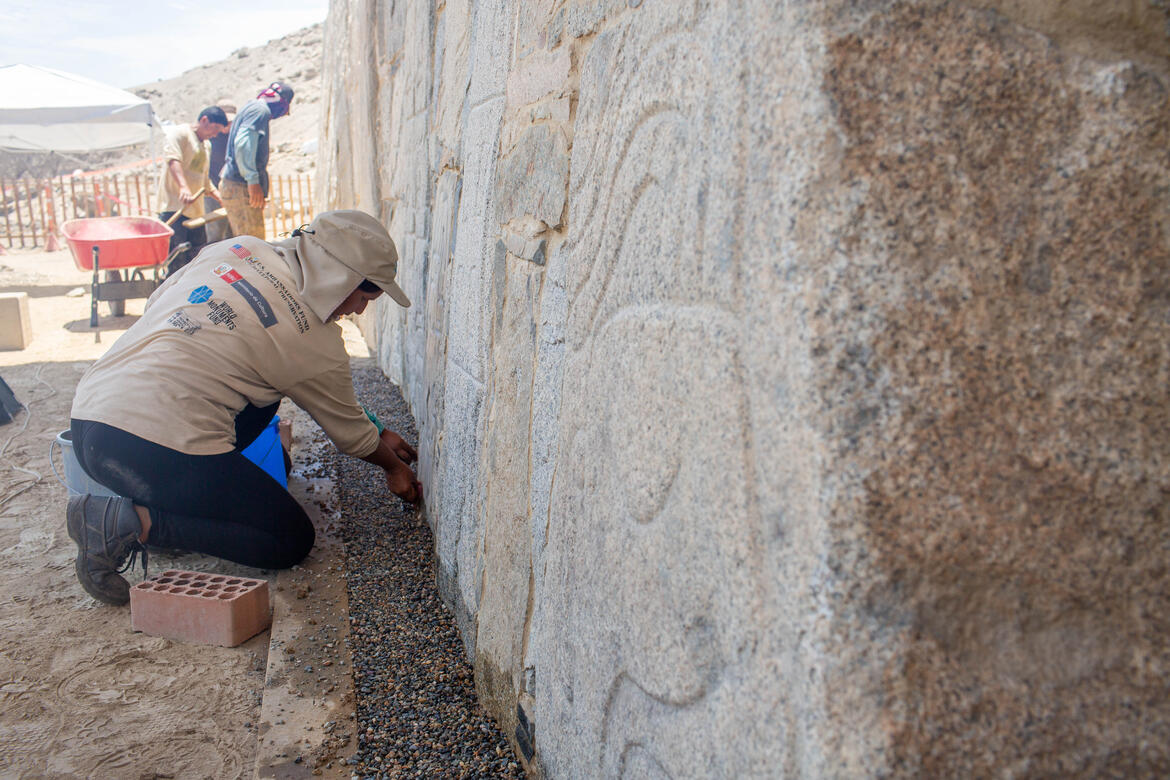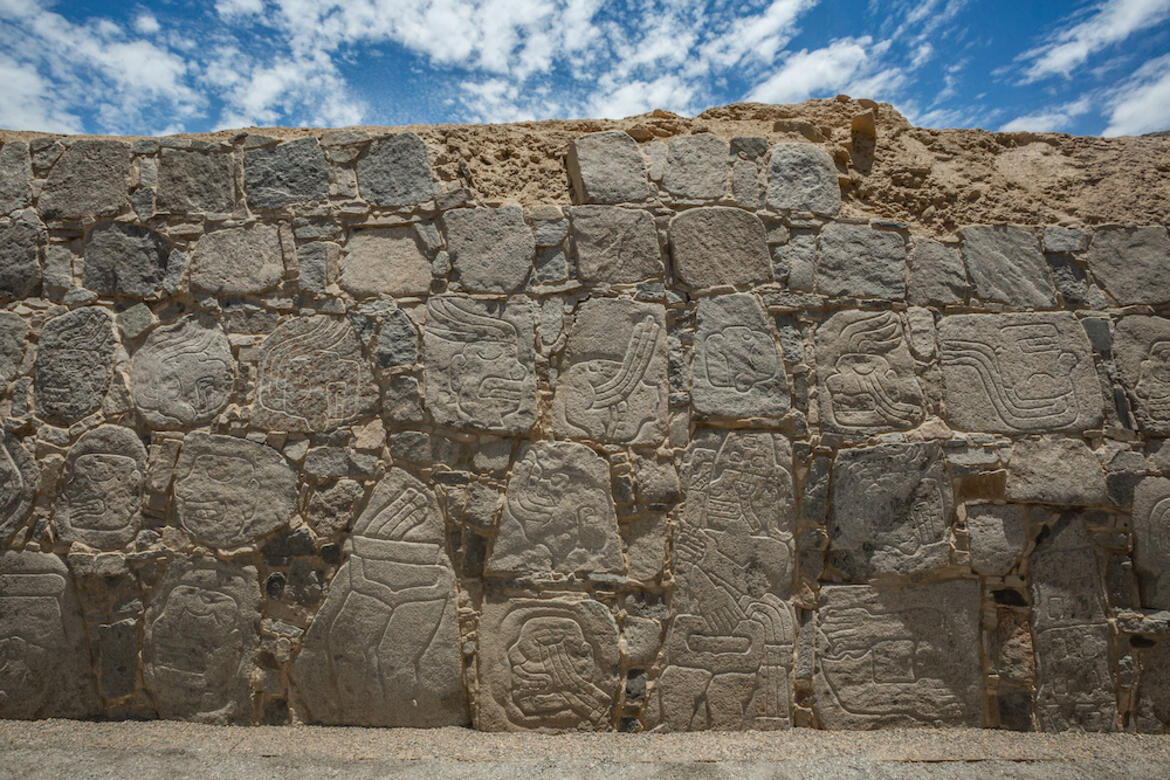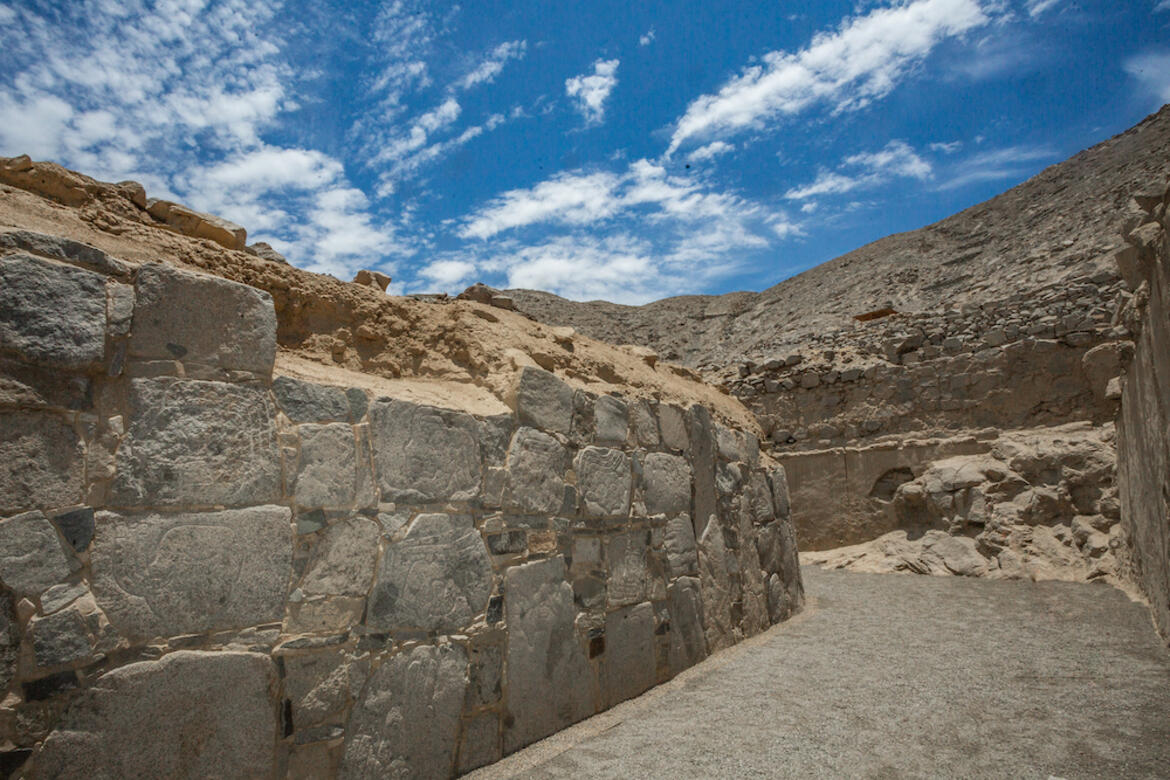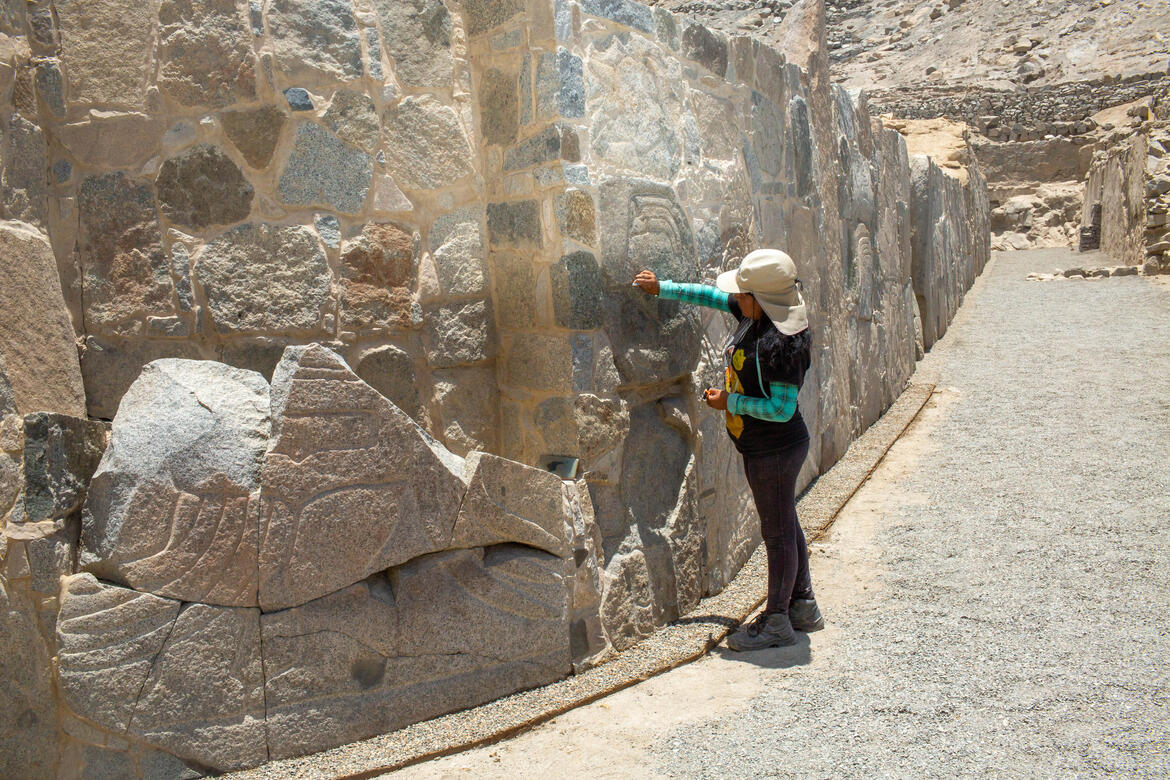Spotlight from the Field: A Look at the Conservation of the Stone Slabs at Cerro Sechín, Peru
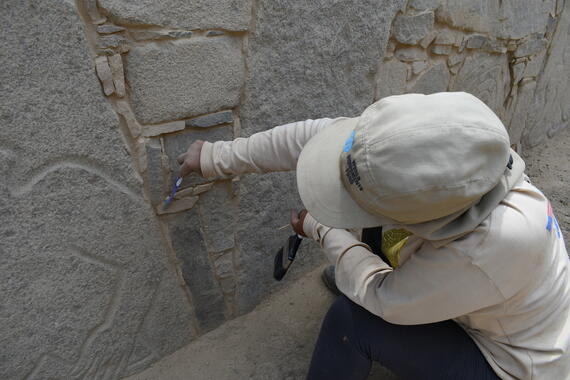
Cerro Sechín, an archaeological site in northern Peru, is notable for its artistically carved stone slabs, which are approximately 4,000 years old and have been identified as the oldest stone carvings in Latin America. Their iconography, executed in low relief, depicts human body parts and is distributed across the wall of the archaeological site’s main building. These artworks were recently preserved by applying specialized stone conservation techniques that have rarely been used in Peru.
Ingrid García Miranda, who led the conservation component of another World Monuments Fund (WMF) project in Peru, explains the evolution of the conservation processes carried out at Cerro Sechín and her experience there.
Cerro Sechín is located in the the region of Áncash in Casma Province. It sits on the slope of a hill named Cerro Sechín, where we can identify the quarries from whose rocky outcroppings stone would have been extracted. The lithic wall around the site’s main building is composed of around 300 carved stone slabs originating from this quarry. The iconography sculpted by Sechín's ancient inhabitants, which has survived for millennia, continues to impress those who visit the site today.
However, due to the age of the stones and exposure to the elements, the condition of the slabs was a cause for concern, and they were at risk of loss. In 2020, thanks to the WMF, I carried out a diagnosis of the condition of the stone slabs with the objective of undertaking actions for the stones’ conservation and protection, avoiding the loss of existing iconography. The result allowed for the development of the intervention methodology carried out between May 2022 and February 2023, processes that I had the opportunity to direct together with a team that specialized in lithic conservation.
The iconography of the stone slabs was first brought to the attention of the scientific public in 1937 by the father of Peruvian archaeology, Julio C. Tello. The figures that can be seen at the site are impressive since they consist of dismembered parts of the human body. In addition to severed limbs, there are also heads, ears, eyes, and internal organs, such as the stomach, the intestines, the brain, vertebrae, and fluids like blood gushing forcefully from faces, eyes, heads, and legs, among other parts.
We first began by studying the deterioration agents on the stone slabs' surface. Our team demonstrated the risk of irreversible loss of the characteristic iconography on the stones’ surface via detachment. Through photogrammetry, it was possible to obtain precise documentation of the pieces and the level of damage they had suffered. We also applied physical-chemical studies, such as petrographic studies, to identify that granite was the type of stone used at this site. We also investigated the alterations in the mortar at the joins and at the top of the wall.
A number of factors have contributed to the deterioration of the stone carvings. Salt saturation, abrasion, wind erosion, extreme temperature oscillation, the composition of the stone itself, the aging level of its mineralogical components, and the environmental conditions of the site have all converged to increase the deterioration of the slabs. In the course of our intervention, we were also able to identify other problems related to components of the building's architecture and elements introduced during another era and period of occupation at the site. The lack of a drainage system, water stagnation during rainy seasons, and materials left behind by previous archaeological interventions all contribute to deterioration at the site.
We used both dry and wet cleaning methods, as well as desalination systems with cellulose and clay pastes. We studied the mortar and treated it with natural materials like cactus mucilage, ash water, river sand, and clay. To consolidate the stone, we used a low-percentage epoxy resin mixed with crushed stone, utilizing a color palette according to the colors of the local rocks. The treatment was applied promptly to layers of stone that were vulnerable to detachment. Finally, we undertook chemical consolidation using silica-based sprays and other materials based on nanotechnology.
The team was made up of professionals specialized in stone conservation, a geological and chemical scientific specialist (Carlos Cano), a specialist architect (Shelby Paz), and myself. Together, we were in charge of training professionals and local residents in the field of stone conservation. A foundational aim of the project was women's empowerment; as such, we were sure to encourage the participation of local women, providing them with technical and scientific knowledge and training in the methodology of the procedures we carried out.
A fundamental part of our project was an interdisciplinary approach developed together with professionals from other fields. Archaeologist Bryan Núñez, for example, aided in the development of documentation before, during, and after the project by, developing a database of the background, condition, characteristics, and interventions carried out on each individual slab. Conservator Leslie Zúñiga was my great support in all the research and recording of the materials' behavior in the field in the temporary laboratory we set up at the quarry.
The work we carried out achieved 100% of the goals we had set. As we worked with non-specialized personnel, we were also able to make a significant contribution by training local residents in every aspect of the work, using the project as a field school. We have left behind us a new team of workers specialized in stone conservation for future projects, should the need arise.
Ingrid García is a professional visual artist specialized in the conservation and restoration of artworks. She completed her master's in Cultural Heritage Management at the National University of San Marcos in Lima. She holds a bachelor’s degree in Conservation and Restoration of Artworks from the National University of Diego Quispe Tito in Cusco. She also has a degree in Management Studies and Environmental Impact Assessment from Ricardo Palma University in Lima. She was a scholar at the19th International Course on Stone Conservation organized by the International Center for the Study of the Preservation and Restoration of Cultural Property (ICCROM) and Getty Conservation Institute (GCI) in 2015.
She has 14 years of professional experience in the cultural heritage field, eight of them at the Ministry of Culture of Peru. She focuses on movable and immovable cultural assets, stone conservation, project development, supervision and teaching.
World Monuments Fund’s work at Cerro Sechín is made possible in part by our project funders, the U.S. Ambassadors Fund for Cultural Preservation (AFCP) and the U.S. Embassy in Peru, as well as Tianaderrah Foundation / Nellie and Robert Gipson and Nor Oil SAC; and our project partners, Proyecto Arqueológico Cerro Sechín and the Dirección Desconcentrada de Cultura de Áncash del Ministerio de Cultura del Perú.
Learn More
World Monuments Fund safeguards cultural heritage around the globe, ensuring our treasured places are preserved for present and future generations.
Sign up for our newsletter to receive regular updates on our projects, stories from the field, upcoming events, and more!

